

A paper pallet or ecopallet is a shipping or display pallet made from paperboard.


A paper pallet or ecopallet is a shipping or display pallet made from paperboard.
Paper shipping pallets come in corrugated fiberboard, partial wood decks or engineered with laminated paperboard. Some are made of paperboard composite honeycomb. Several designs have been developed. [1] [2] [3]

Corrugated fiberboard, corrugated cardboard, or corrugated is a type of packaging material consisting of a fluted corrugated sheet and one or two flat linerboards. It is made on "flute lamination machines" or "corrugators" and is used for making corrugated boxes. The corrugated medium sheet and the linerboard(s) are made of kraft containerboard, a paperboard material usually over 0.25 millimetres (0.01 in) thick.

A box is a container with rigid sides used for the storage or transportation of its contents. Most boxes have flat, parallel, rectangular sides. Boxes can be very small or very large and can be used for a variety of purposes, from functional to decorative.

Paperboard is a thick paper-based material. While there is no rigid differentiation between paper and paperboard, paperboard is generally thicker than paper and has certain superior attributes such as foldability and rigidity. According to ISO standards, paperboard is a paper with a grammage above 250 g/m2, but there are exceptions. Paperboard can be single- or multi-ply.

Packaging is the science, art and technology of enclosing or protecting products for distribution, storage, sale, and use. Packaging also refers to the process of designing, evaluating, and producing packages. Packaging can be described as a coordinated system of preparing goods for transport, warehousing, logistics, sale, and end use. Packaging contains, protects, preserves, transports, informs, and sells. In many countries it is fully integrated into government, business, institutional, industrial, and for personal use.

A drum is a cylindrical shipping container used for shipping bulk cargo. Drums can be made of steel, dense paperboard, or plastic, and are generally used for the transportation and storage of liquids and powders. Drums are often stackable, and have dimensions designed for efficient warehouse and logistics use. This type of packaging is frequently certified for transporting dangerous goods. Proper shipment requires the drum to comply with all applicable regulations.
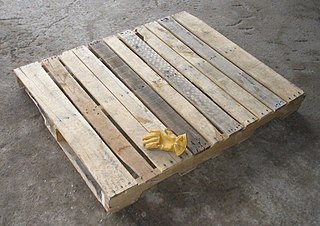
A pallet is a flat transport structure, which supports goods in a stable fashion while being lifted by a forklift, a pallet jack, a front loader, a jacking device, or an erect crane. Many pallets can handle a load of 1,000 kg (2,200 lb). While most pallets are wooden, pallets can also be made of plastic, metal, paper, and recycled materials.

Cardboard boxes are industrially prefabricated boxes, primarily used for packaging goods and materials. Specialists in industry seldom use the term cardboard because it does not denote a specific material. The term cardboard may refer to a variety of heavy paper-like materials, including card stock, corrugated fiberboard, and paperboard. Cardboard boxes can be readily recycled.
Coated paper is paper that has been coated by a mixture of materials or a polymer to impart certain qualities to the paper, including weight, surface gloss, smoothness, or reduced ink absorbency. Various materials, including kaolinite, calcium carbonate, bentonite, and talc, can be used to coat paper for high-quality printing used in the packaging industry and in magazines.
Skin pack, or skin packaging, is a type of carded packaging where a product is placed on a piece of paperboard or in trays, and a thin sheet of transparent plastic is placed over the product and paperboard or trays. The printed paperboard/tray usually has a heat-seal coating. The plastic film is softened by heat and draped over the product on the card/tray. Vacuum is used to assist a firm fit. The film bonds to the heat-seal coating on the paperboard.

Package pilferage is the theft of part of the contents of a package. It may also include theft of the contents but leaving the package, perhaps resealed with bogus contents. Small packages can be pilfered from a larger package such as a shipping container. Broader and related aspects of package theft may include taking the entire package, pallet load, truck load, shoplifting, etc. The theft may take place at any point in the parcel's journey from source to destination, including theft by rogue logistics employees and customs agents in international mail scenarios.

A bulk box, also known as a bulk bin, skid box, pallet box, bin box, gaylord, or octabin, is a pallet-size box used for storage and shipping of bulk or packaged goods. Bulk boxes can be designed to hold many different types of items such as plastic pellets, watermelons, electronic components, and even liquids; some bulk boxes are stackable.
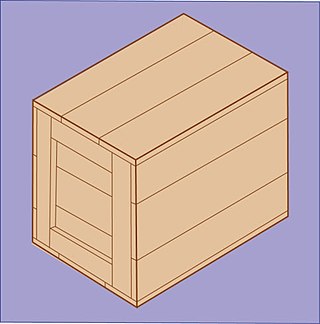
A wooden box is a container made of wood for storage or as a shipping container.

A padded envelope, also known as a padded or cushioned mailer, or jiffy bag in the United Kingdom, is an envelope incorporating protective padding to protect items during shipping. The padding is usually thick paper, bubble wrap, or foam.

The container compression test measures the compressive strength of packages such as boxes, drums, and cans. It usually provides a plot of deformation vs compressive force.
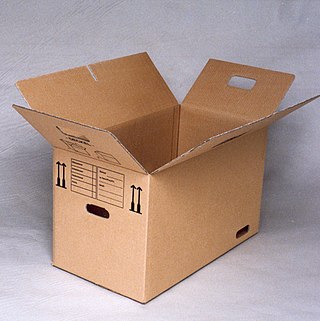
Corrugated box design is the process of matching design factors for corrugated fiberboard or corrugated plastic boxes with the functional physical, processing and end-use requirements. Packaging engineers work to meet the performance requirements of a box while controlling total costs throughout the system. Corrugated boxes are shipping containers used for transport packaging and have important functional and economic considerations.

In technical usage in the shipping industry, a pail is a type of cylindrical shipping container with a capacity of about 3 to 50 litres. It can have straight or slanted sides and usually has a handle or bail. In non-technical usage, a pail is synonymous with a bucket.

A multi-pack also known as multipack is packaging that combines or holds multiple items or smaller packages.
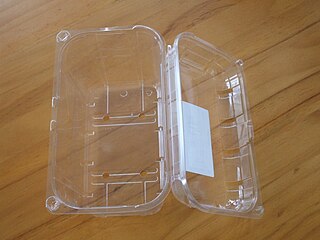
A clamshell is a one-piece container consisting of two halves joined by a hinge area which allows the structure to come together to close. Clamshells can be made to be reusable and reclosable or can be sealed securely.
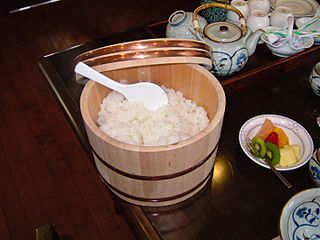
A tub is an open-top circular or oblong container. In earlier times they were made from wooden staves held together with iron hoops and were made by coopers. Modern tubs used in industry might be made from concrete, metal or plastic.

A shipping tube, mailing tube, or cardboard tube is a shipping container used to ship long items. It is usually a long package with a narrow cross-section: square, triangle, or round.